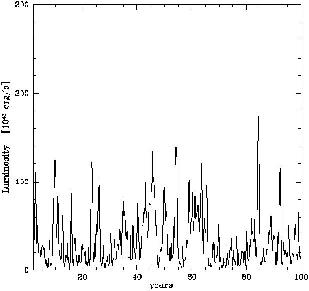


2.6. Stellar Collisions
There is a tight analogy between the tidal disruption of stars
by the black hole and the disruption of two stars during
a head-on collision. The
factor  =
vcoll / v* (v* = 500km/s for a solar
mass star) regulates the fate of collisions, and is equivalent
to the factor of penetration of the star inside the tidal
radius RT / rperi, where rperi is the
pericenter of the stellar orbit.
=
vcoll / v* (v* = 500km/s for a solar
mass star) regulates the fate of collisions, and is equivalent
to the factor of penetration of the star inside the tidal
radius RT / rperi, where rperi is the
pericenter of the stellar orbit.
 = 1, the
collision occurs near the
collision radius Rcoll, there is coalescence of the two stars;
the result may quickly explodes as a supernova.
= 1, the
collision occurs near the
collision radius Rcoll, there is coalescence of the two stars;
the result may quickly explodes as a supernova.
 > 1 a
fraction of the mass is lost, and fuels the black hole.
> 1 a
fraction of the mass is lost, and fuels the black hole.
 >> 1
(well inside Rcoll), a deformation in
pancakes occurs, very similar to the tidal disruption, when
RT / rperi >> 1.
Gas and debris are bound to the black hole.
>> 1
(well inside Rcoll), a deformation in
pancakes occurs, very similar to the tidal disruption, when
RT / rperi >> 1.
Gas and debris are bound to the black hole.
Stellar collisions help to refill the loss-cone, although they flatten the stellar cusp (Rauch 1999). The collisions rate is comparable to the diffusion rate, that refill the central core.
It is now generally accepted that
for low density nuclei, stellar evolution and
tidal disruption is the main mechanism
to bring matter to the black hole, and
for high density nuclei, stellar collisions
dominate the gas fueling.
The evolution of the stellar density through these processes
is then opposite, and accentuates the differences:
- for n < 107 / pc3 the core then expands, due to
heating that results from the settling of a small
population of stars into orbits tightly bound to
the black hole;
- for n > 107 / pc3, the core shrinks due to the
removal of kinetic energy by collisions.
To give an order of magnitude, the nuclear density
in our own Galaxy is estimated at
108 M /
pc3
(Eckart et al 1993).
/
pc3
(Eckart et al 1993).
These mechanisms produce differing power-law slopes in the resulting stellar density cusp surrounding the black hole, -7/4 and -1/2 for low- and high-density nuclei, respectively (Murphy et al 1991, Rauch 1999). In simulations however (Rauch 1999), collisions tend to produce a flat core, instead of r-1/2 law in Fokker-PLank studies, which imply isotropy (and are unable to treat sparse regions).
Finally, stellar collisions could explain both the high luminosities (up to 1045 ergs/s, Spitzer & Saslaw 1966, Colgate 1967), and the variability of some QSOs (~ 10yr scale) according to Courvoisier et al (1996), see figure 3.

|
Figure 3. Light curve produced by the
energy released in star collisions, with a collision
rate of |
But still, even with collisions, the most active quasars
requiring 100 M / yr
remain to be fueled.
May be the gas from stars disruption can be
stored in a disk,
and suddenly poured in a burst of activity ?
(Shields &
Wheeler 1978).
There might be tight
relations with nuclear starbursts
(Norman &
Scoville 1988,
Perry 1992,
Williams et al 1999).
/ yr
remain to be fueled.
May be the gas from stars disruption can be
stored in a disk,
and suddenly poured in a burst of activity ?
(Shields &
Wheeler 1978).
There might be tight
relations with nuclear starbursts
(Norman &
Scoville 1988,
Perry 1992,
Williams et al 1999).